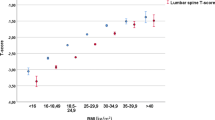Abstract
Introduction
We wanted to examine whether the features of the metabolic syndrome carried an increased risk of non-vertebral fracture.
Methods
This is a population-based, 6-year follow-up of 27,159 subjects from the municipality of Tromsø, followed from 1994 until 2001. Age range was 25–98 years. Non-fasting serum levels of high-density lipoprotein (HDL), triglycerides and glucose, blood pressure (BP), weight and height were measured at baseline. All non-vertebral fractures were registered by computerised search in radiographic archives.
Results
A total of 1,249 non-vertebral fractures were registered. Increasing number of metabolic syndrome features was associated with significantly reduced fracture risk in both men and women, p= 0.004 and p<0.0001, respectively. High BP was protective against fracture in men [relative risk (RR) 0.89; 95% confidence interval (CI) 0.8–0.99)] while increased body mass index (BMI) was protective in women (RR 0.91; 95% CI 0.84–0.98). Increasing non-fasting serum levels of HDL increased fracture risk in women (RR 1.12; 95% CI 1.05–1.21). BMI modified the effect of HDL in men. Accordingly, high HDL increased fracture risk in men with high BMI (RR 1.51; 95% CI 1.2–1.9).
Conclusions
Increasing burden of metabolic syndrome features protects against non-vertebral fractures. Reduced non-vertebral fracture risk was associated with high BP in men and increased body mass in women. Lower non-fasting serum levels of HDL protect against fractures in women and obese men.


Similar content being viewed by others
References
Meyer HE, Tverdal A, Falch JA (1993) Risk factors for hip fracture in middle–aged Norwegian women and men. Am J Epidemiol 137:1203–1211
Cappuccio, FP et al. (1999) High blood pressure and bone-mineral loss in elderly white women: a prospective study. Study of Osteoporotic Fractures Research Group. Lancet 354(9183):971–975
Lidfeldt J, et al. (2002) The influence of hormonal status and features of the metabolic syndrome on bone density: a population-based study of Swedish women aged 50 to 59 years. The women’s health in the Lund area study. Metabolism: Clinical & Experimental 51(2):267–270
Varosy PD, et al. (2003) Fracture and the risk of coronary events in women with heart disease. American Journal of Medicine 115(3):196–202
Isomaa B, (2003) A major health hazard: the metabolic syndrome. Life Sciences 73(19):2395–2411
Schwartz AV, et al. (2001) Older women with diabetes have an increased risk of fracture: a prospective study. [see comment]. Journal of Clinical Endocrinology & Metabolism 86(1):32–38
Forsen L, et al. (1999) Diabetes mellitus and the incidence of hip fracture: results from the Nord-Trondelag Health Survey. Diabetologia 42(8):920–925
Heath H 3rd, Melton LJ 3rd, Chu CP (1980) Diabetes mellitus and risk of skeletal fracture. New England Journal of Medicine 303(10):567–570
Seeley DG, et al. (1996) Predictors of ankle and foot fractures in older women. J Bone Miner Res 11(9):1347–1355
Schirmer H, Lunde P, Rasmussen K (1999) Prevalence of left ventricular hypertrophy in a general population; The Tromso Study.[see comment]. European Heart Journal 20(6):429–438
The-Tromsø-Study, http://www.ism.uit.no/tromso5/forsteskjema-t4-eng.pdf. 1994
Expert Panel on Detection, E. and A. Treatment of high blood cholesterol (2001) In: Executive Summary of The Third Report of The National Cholesterol Education Program (NCEP) Expert Panel on Detection, Evaluation, And Treatment of High Blood Cholesterol In Adults (Adult Treatment Panel III) [see comment]. JAMA 285(19):2486–9247
Han TS (2002) Analysis of Obesity and Hyperinsulinemia in the Development of Metabolic Syndrome: San Antonio Heart Study. Obes Res Sep 10(9):923–931
Alberti KG, Zimmet PZ (1998) Definition, diagnosis and classification of diabetes mellitus and its complications. Part 1: diagnosis and classification of diabetes mellitus provisional report of a WHO consultation [see comment]. Diabetic Medicine 15(7):539–553
Joakimsen RM, et al (2001) The Tromso study: registration of fractures, how good are self-reports, a computerized radiographic register and a discharge register? Osteoporos Int 12(12):1001–1005
INSTITUTE, S., SAS/STAT Guide for Personal Computers. Version 6 edition. 1992, Cary, NC (USA): SAS Institute
Hanley DA, et al (2003) Associations among disease conditions, bone mineral density, and prevalent vertebral deformities in men and women 50 years of age and older: cross-sectional results from the Canadian Multicentre Osteoporosis Study. Journal of Bone & Mineral Research 18(4):784–790
Varenna M, et al (2001) Unbalanced diet to lower serum cholesterol level is a risk factor for postmenopausal osteoporosis and distal forearm fracture. Osteoporosis International 12(4):296–301
Joakimsen RM, et al. (1998) The Tromso Study: body height, body mass index and fractures. Osteoporos Int 8(5):436–442
Cummings SR, et al. (1985) Epidemiology of osteoporosis and osteoporotic fractures. Epidemiol Rev 7:178–208
Grisso JA, et al. (1991) Risk factors for falls as a cause of hip fracture in women. The Northeast Hip Fracture Study Group. N Engl J Med 324:1326–1331
Jaglal SB, Kreiger N, Darlington G (1993) Past and recent physical activity and risk of hip fracture. Am J Epidemiol 138:107–118
Michaelsson K et al. (1995) Diet, bone mass, and osteocalcin: A cross-sectional study. Calcif Tissue Int 57:86–93
McNair P, et al. (1979) Bone mineral loss in insulin-treated diabetes mellitus: studies on pathogenesis. Acta Endocrinologica 90(3):463–472
Okazaki R et al. (1997) Metabolic improvement of poorly controlled noninsulin-dependent diabetes mellitus decreases bone turnover. Journal of Clinical Endocrinology & Metabolism 82(9):2915–2920
Rosato MT, Schneider SH, Shapses SA (1998) Bone turnover and insulin-like growth factor I levels increase after improved glycemic control in noninsulin-dependent diabetes mellitus. Calcified Tissue International 63(2):107–111
Balint E et al. (2001) Glucose-induced inhibition of in vitro bone mineralization. Bone 28(1):21–28
Barrett–Connor E, Kritz–Silverstein D(1996) Does hyperinsulinemia preserve bone?[see comment]. Diabetes Care 19(12):1388–1392
Author information
Authors and Affiliations
Corresponding author
Additional information
An erratum to this article can be found at http://dx.doi.org/10.1007/s00198-009-0847-8.
Rights and permissions
About this article
Cite this article
Ahmed, L.A., Schirmer, H., Berntsen, G.K. et al. Features of the metabolic syndrome and the risk of non-vertebral fractures: The Tromsø study. Osteoporos Int 17, 426–432 (2006). https://doi.org/10.1007/s00198-005-0003-z
Received:
Accepted:
Published:
Issue Date:
DOI: https://doi.org/10.1007/s00198-005-0003-z



